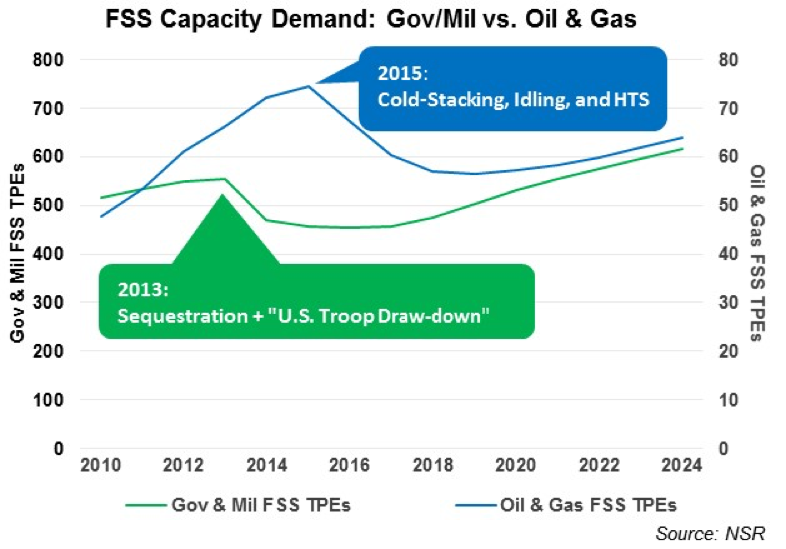Is Energy the Next
“Post-Surge” Gov-Mil Market?
Apr 7th, 2016 by
Brad Grady, NSR
It
is no big secret that satellite
communications players in the
Energy market have been hit
hard, from service providers all
the way up to satellite
operators. Between the
‘if-it-ain’t-broke’ mindset
prevalent in the Oil & Gas
industry to the U.S. Government
purchasing a keg’s worth of
capacity one-pint-at-a-time,
each market has run up against
funding pressures that are
causing rapid (so-to-speak)
changes in the way satellite
communications are designed,
acquired, and utilized.
Just as sequestration put a
major dampener on revenues for
Gov & Mil SATCOM markets,
crude-oil pricing has caused a
readjustment across the energy
sector. With the cost to
produce above to well-above the
current market rate for a barrel
of oil in some major producing
regions, upstream oil and gas
companies particularly have been
forced to look at new
and innovative ways to operate.
Introduce more technology in
more places to get more data to
enable quicker decisions, and
that will help lower cost of
extraction/production – in other
words: ‘big data.’
In Gov & Mil Markets, ISR
(Intelligence, Surveillance,
Reconnaissance) is the ‘big
data’ thrust of recent years.
Central to both is building the
infrastructure and networks to
keep all sites communicating
with each other.
However, the industry cannot
connect what does not exist and
just as Gov & Mil markets saw
declines after the troop
withdrawal from the Middle East,
rig stacking and vessel idling
in the Oil and Gas industry has
similarly impacted the key
segment of the Energy markets.
Nowhere is this stronger than in
a comparison between FSS
capacity demand in Gov & Mil and
Oil & Gas markets.
Looking historically since 2010,
Gov & Mil markets saw ‘peak FSS
Capacity’ in 2013 – when the
U.S. Troop draw-down in the
Middle East and sequestration
took their respective toll.
For Oil & Gas, 2015 was
the year in which ‘peak FSS
capacity’ occurred,
driven by the widespread
cold-stacking of rigs and idling
of Offshore Support Vessels
across the major oil plays.

While NSR does project in its
Government and Military
Satellite Communications, 12th
Edition report an eventual
return to growth in-line with
2013 trends for FSS capacity,
FSS capacity for the Oil & Gas
Industry is not expected to
recover in the foreseeable
future. Why the
difference? For Oil & Gas,
a quicker, deeper
integration of HTS-delivered
services will reduce the
longer-term opportunity for FSS.
Already, O3b is disrupting
connectivity to larger deep
water plays, while EPIC, GX and
the host of other GEO-HTS
offerings will prove similarly
disruptive for other segments of
the Oil & Gas market.
Bottom Line
Although challenges persist
in the Energy markets, as NSR
highlights in its Energy
Markets via Satellite, 6th
Edition report,
opportunities still exist for
those market players willing to
look for them. Some come
in the form of contract renewals
such as Harris CapRock’s renewal
of Transocean or through new
wins such as ITC Global’s “New
Offshore Energy Services
Customer.” However, the
underlying theme for almost all
of these announcements is
innovation – either
innovation in terms of the
business model for Harris
CapRock’s single, global pricing
point for Transocean or
technical/service orientated
with ITC Global’s Crew
Welfare-centric application.
Another core part of this
innovation? The steady
transition towards HTS.
For Oil & Gas, the market has
broken, and now is the time for
satellite communications players
to provide solutions to fix it.